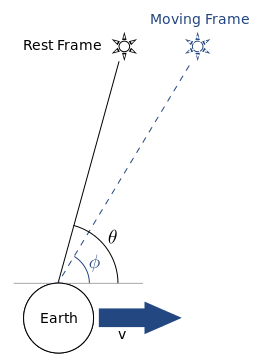
The aberration of starlight (also called stellar aberration) is an astronomical phenomenon which produces an apparent motion of stars about their locations dependent on the velocity of the observer. Aberration causes objects to appear to be angled or tilted towards the direction of motion of the observer compared to when the observer is stationary. The change in angle is very small, and specified by the ratio of v/c where c is the canonical speed of light and v the velocity of the observer. With annual stellar aberration, the apparent change in the position of a star varies as observed by an Earth observer periodically over a year as the Earth’s velocity changes as it revolves around the Sun, with a maximum angle of about 20 arc-seconds in right ascension or declination. It traces a small ellipse on the sky over that time.
The fact of stellar aberration, which has been explained by a constant speed of light c, has been used by some to “refute” the idea of an infinite one-way speed of light in Lisle’s ASC model. The claim is that aberration would not occur at all if the one-way incoming speed of light was infinite, thus v/c = 0, here. Dr Jason Lisle responds to this claim.
Starlight aberration also occurs under the Anisotropic Synchrony Convention (ASC). Many events in relativistic physics have two (or more) different explanations depending on the reference frame. In the famous twin paradox, all agree that an astronaut travelling sufficiently close to the speed of light is able to reach a star 40 light-years away while aging only 1 year. But the explanation depends on the observer. From the Earth observer’s point of view, the astronaut experienced massive time-dilation, and hence aged only one year while 40 years elapsed on earth. From the astronaut’s perspective, his time is perfectly normal, but the universe is length-contracted in his direction of motion, so the star’s distance was compressed to less than 1 light-year. Both explanations are correct, each from the given point of view, even though they differ.
Likewise, starlight aberration also occurs under the anisotropic synchrony convention, and the angle is exactly the same as it is under the Einstein Synchrony Convention (ESC) but the explanation differs. Recall that matter is not infinitely rigid. In relativity, an object in motion will become compressed along the direction of motion – length contraction. When the one-way speed of light is not isotropic, there are additional effects, such as shearing. (This is necessarily the case because molecules are held in place by electromagnetic forces, which propagate at the speed of light.)
Consider a stationary telescope pointed vertically and centered on a star directly overhead. Now, we consider the same telescope, but moving horizontally to the left at high speed. Under ASC, with the downward directed light being instantaneous, the moving telescope must shear such that the top lags behind the bottom. Thus, it is no longer pointed at the star. To compensate, we must tilt the telescope forward by the shear angle in order to once again be pointed at the star. The Lorentz aberration angle is exactly the same for ESC and ASC.
It is always necessarily the case that ASC and ESC produce the same measurable results, since they are merely two different coordinate systems – two methods of marking the (x,y,z,t) of any event.
There are probably several ways to explain the effect and illustrate why it must occur. Mathematically it arises from the epsilon-Lorentz transformations. These are the generalized Lorentz equations without one-way light velocity assumptions, and are derived in section 8 of John Winnie’s 1970 paper, “Special Relativity without one-way velocity assumptions: Part II.” Physically, shearing must occur because the information transmitted in the molecular bonds is no longer isotropic under ASC, since it travels at the one-way speed of light.
But I think the easiest way to illustrate this is geometrically. You have probably seen geometric proofs of time-dilation and length contraction, where a light-clock is examined from both the stationary frame and then from a moving frame. Such effects must occur in order to keep the speed of light invariant. In the same way, we can show that non-isotropic one-way light propagation must require moving matter to shear in the direction orthogonal to the anisotropy by thought experiment.
Consider a light-clock: a tall, narrow box with two mirrors – one on the ceiling and the other on the floor. A single photon of light is constantly bouncing orthogonally from one mirror to the other. (See animation below) If the box is 186,282 miles [299,792 km] tall, it takes light two seconds to return to its point of origin. By ESC reckoning, the light takes one second to go from the floor to the ceiling, and one second to return to the floor. By ASC reckoning, taking the downward light to be the infinite direction, the light takes two seconds to go from the floor to the ceiling, and no time at all to return.
If you then examine the same scenario from an observer who is moving to the right at high speed relative to the light clock, you can see geometrically that the clock must shear in order for the light to hit the mirror at the right time. I’ve illustrated with a short animation. The first slide is for a stationary frame and the second for a moving reference frame.
https://www.bitchute.com/video/kpH5wv4C7ZDx
Video of a light box, created by Jason Lisle.
If the video does not play properly download this Powerpoint presentation aberration of starlight (click here)
Update added November 20, 2015
Jason Lisle: The animation wasn’t to illustrate aberration per se. Rather, it was to answer the question about why moving matter shears under ASC. It’s the same type of geometric proof that Einstein used to demonstrate length contraction in matter and time dilation. Once we understand that moving matter shears under ASC, it becomes obvious that stellar aberration must occur. The stationary telescope is pointed vertically at a star directly overhead. When the same telescope is moved at high speed, it shears such that the top lags behind the bottom (as demonstrated by the light box Gedanken experiment) as observed by a stationary observer, and thus is no longer aimed at the star. It must be tilted forward by the stellar aberration angle in order to once again be pointed at the star.
John G. Hartnett: I would say that the way to think about the light box (above) and how it relates to stellar aberration is via the moving telescope, which is needed to determine direction of the star. The rebounding (or outward) light signal in the ASC case of the moving light box is found in the electromagnetic forces between the atoms that make up the telescope. That is required because the telescope is moving and thus a sheering force is applied (in the rest frame of the observer), which propagates along the length of the telescope from the eye-piece to the top (where the last atom in the structure is) travelling at the speed of light ½c, under the ASC.
One might also think of it another way. Imagine that the atoms at the top of the telescope need synchronisation to the atoms at the eye-piece. Here you have a classic synchronisation problem. The electromagnetic forces holding all the atoms of the telescope together provide the link for that synchronisation. You could even consider a sound wave is passed from the eye-piece (the receiving clock) back to the top of the telescope (emitting clock source) as the telescope is physically turned to remain positioned on the star. But electromagnetic energy travels fastest and that is limited to ½c under ASC, in the rest frame of the observer at the eye-piece.
Now you might ask, where is the clock at the top of the telescope? The top is defined by the atoms in the telescope structure that must be held together for the moving telescope to be agile to track the position of the star. When the telescope is moved each atom through the structure communicates with the next via their electromagnetic coupling. The idea of a clock is a notional concept. The observer at the eye-piece assumes the structure of the telescope is intact during his measurement, which is facilitated by the signal that is passed to the top of the telescope via this electromagnetic coupling.
Here it is only an assumption that all the atoms are in a sense synchronised under the effect of the shearing forces applied to the telescope. You could imagine that at every point along the telescope the atoms are acting as clocks. Their relative motion to each other would change their synchronisation. So how could you verify that the telescope is pointing “straight” where you expect it to be even though moving. You could send a light signal to check the alignment of the structure. The act of sending the aligning or synchronising light signal means you do not know where the telescope is pointing without some additional measurement. It has become a practice to use a laser to align the adaptive mirrors in the large optical and infrared telescopes.
Stellar aberration does measure the “one-way” speed of light, and there are published papers on this, i.e. using GPS satellite clocks. For example, Wolf, P. and Petit, G. “Satellite test of special relativity using the global positioning system”. Physical Review A 56 (6): 4405–4409, 1997. doi:10.1103/PhysRevA.56.4405. The authors of that paper know the reality of genuine one-way speed of light measurements. They implicitly assume their GPS clocks are synchronised with the Einstein convention (ESC). Measurement of the one-way speed of light cannot be made apart from a choice of a simultaneity convention. That means the separated clocks (in the GPS satellites, in this case) are assumed to be synchronised, and thus, in fact, it is a two-way speed measurement.
But in all of this, ASC and ESC are merely two different choices of timing conventions. They all depend on the value of ε in Special Relativity theory. Einstein chose ε = ½, but it can have any value between 0 and 1. All are valid choices. There is no natural choice for the universe. See the “Synchronization conventions” section in Wikipedia. Thus it is merely a coordinate transformation. To deny that you are denying basic physics (and philosophy) at the heart of modern physics.
Additional Reading
- R. Newton, Distant starlight and Genesis: conventions of time measurement, Journal of Creation 15, no. 1: 80-85, 2001; J.P. Lisle, Anisotropic Synchrony Convention—A Solution to the Distant Starlight Problem, Answers Research Journal 2:191–207, 2010.
- J.G. Hartnett, Synopsis: A biblical creationist cosmogony
- J.G. Hartnett, Expansion of space – a dark science
- J.G. Hartnett, A biblical creationist cosmogony
- J.G. Hartnett, Speculation on redshift in a created universe
- J.G. Hartnett, Supernova remnants and the age of the Universe
Recommended Reading
- Book: Merchants of Death: Global Oligarchs and Their War On Humanity
- Book: Apocalypse Now: On the Revelation of Jesus Christ
Follow me
- Telegram.org: @GideonHartnett
- Facebook: Gideon Hartnett
- X (Twitter): @gideon195203

To be notified by email put your email address in the box at the bottom of your screen. You’ll get an email each time we publish a new article.

Click this image to make a secure Donation (Stripe) !







4 responses to “Aberration of Starlight and the One-Way Speed of Light”
How does ASC deal with the concept of light from earth being bounced off TWO distant objects before returning to earth? What speeds exist in each leg of the journey?
LikeLike
You need to do your homework and study the basics. Read the first few listed articles in the Additional Reading section.
The speed of light for any given angle under ASC is:
c = c0/(1-cosθ)
where c0 is the canonical speed of light (c0 = 299,792 km/s) as determined from a two-way speed of light measurement, and θ is the angle of the light relative to the observer. θ = 0 means incident on the observer and θ = 180 degrees means moving away from the observer.
LikeLike
Can ASC explain Cherenkov radiation?
LikeLike
Yes, of course because ASC is just a coordinate transformation. The one-way speed of light outward from the observer in the rest frame of the Cherenkov particles is half the canonical speed c, and at right angles it is c. The ESC may be a simpler convention to use to explain Cherenkov radiation though. The physics does not depend on the choice of coordinates. That is the whole point of relativity theory. See today’s post JASON LISLE DEFENDS HIS ASC MODEL. Though this is not specifically mentioned the same arguments apply.
LikeLike